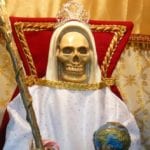 History
History  History
History  Food
Food 10 Weird Foods Inspired by Your Favorite Movies
 Religion
Religion 10 Mind-Blowing Claims and Messages Hidden in the Bible Code
 Facts
Facts 10 Things You Never Knew about the History of Gambling
 Weird Stuff
Weird Stuff 10 Cool and Creepy Facts about Collecting Tears
 Humans
Humans The Ten Most Lethal Gunslingers of the Old West
 Misconceptions
Misconceptions 10 Phony Myths and Urban Legends That Just Won’t Die
 History
History 10 Amazing Roman Epitaphs
 Weird Stuff
Weird Stuff 10 Niche Subcultures That Are More Popular Than You Might Think
 Mysteries
Mysteries 10 Tragic Disappearances and Deaths in Joshua Tree National Park
 History
History Top 10 Tragic Facts about England’s 9 Days Queen
 Food
Food 10 Weird Foods Inspired by Your Favorite Movies
 Religion
Religion 10 Mind-Blowing Claims and Messages Hidden in the Bible Code
Who's Behind Listverse?

Jamie Frater
Head Editor
Jamie founded Listverse due to an insatiable desire to share fascinating, obscure, and bizarre facts. He has been a guest speaker on numerous national radio and television stations and is a five time published author.
More About Us Facts
Facts 10 Things You Never Knew about the History of Gambling
 Weird Stuff
Weird Stuff 10 Cool and Creepy Facts about Collecting Tears
 Humans
Humans The Ten Most Lethal Gunslingers of the Old West
 Misconceptions
Misconceptions 10 Phony Myths and Urban Legends That Just Won’t Die
 History
History 10 Amazing Roman Epitaphs
 Weird Stuff
Weird Stuff 10 Niche Subcultures That Are More Popular Than You Might Think
 Mysteries
Mysteries 10 Tragic Disappearances and Deaths in Joshua Tree National Park
10 Dark Stories Ancients Told About Our Night Skies
The stars in the night sky have captured the imagination of mankind for generations. We’ve seen the Big Dipper, little dogs, hunters, scorpions, and mythical creatures who chase each other across the horizon. We’ve also made up plenty of stories to explain how people and creatures got into the heavens. Some of these stories are extraordinarily disturbing.
10 Algol
The Demon Star
Algol, a star in the constellation Perseus, represents the severed head of Medusa, the Gorgon. In the well-known story, the hero Perseus used Medusa’s own reflection as a weapon against her and then saved her head to employ as a weapon.
The star Algol as a representation of Medusa’s death-causing head is a rather unsettling addition to the star’s mythos. Algol waxes and wanes, seeming to wink in the night sky.
Its name comes from the Arabic word ra’s al-ghul (“the demon’s head”). Today, we know that Algol’s regular blinking happens because it’s actually two stars with different brightness levels that revolve around each other.
The result is a flickering, blinking effect that we see every time it completes its cycle. That happens every two days, 20 hours, and 49 minutes, making it understandably unsettling to ancient eyes.
It’s now believed that the ancient Egyptians used the regular flickering of Algol to help standardize their calendar. They may also have used Algol’s dimming and flickering to track their days.
Back then, the so-called Demon Star may have been viewed as something evil looking down from above. The Egyptian calendar based on the star’s patterns also used the alternating face of the star to determine which days would be lucky or unlucky.
The lucky times—which lasted 2.85 days each—coincided with the cycle from the star’s brightest point to its dimmest. Researchers at the University of Helsinki believe that this concept of luck was connected to the Eye of Horus.
When the star was at its brightest, Horus’s rage-filled eye was believed to be casting its dangerous light on mankind. As the light dimmed, Horus was pacified for the moment.
9 Ophiuchus The Serpent Holder
The Curse Of Erysichthon
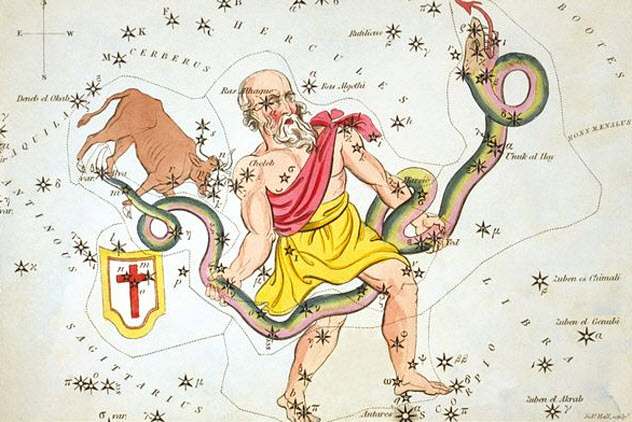
The Ophiuchus constellation sits along the elliptic (the path of the Sun) and opposite the more well-known Orion. It defines the figure of a man holding or wrapped in snakes. The head of the figure is the star Rasalhague (“Head of the Snake Charmer”).
As with most constellations, there are stories associated with Ophiuchus, the serpent holder. He’s sometimes depicted as Asclepius, the Greek physician who was struck down by Zeus to keep him from making the human race immortal.
He’s also associated with the absolutely terrifying story of Erysichthon, son of Triopas, an ancient king of Thessaly. According to the story, Erysichthon led a group of men into a grove of trees that was sacred to Demeter. They cut down the trees and used them to build Erysichthon’s house.
As retribution, Demeter cursed Erysichthon with a hunger that would never be satisfied. He gorged himself on banquet after banquet. Still, he starved. He had 12 men constantly bring him wine. Still, he was thirsty.
The more he ate, the hungrier he got. Finally, he did nothing but eat. His family was forced to tell others that he had gone abroad because he wasn’t able to stop eating long enough to receive a visitor. After he ate everything in his father’s home—even the cat—he was reduced to sitting at a crossroads and begging anyone who passed for food.
Finally, after selling his children into slavery to get more food, he had only one option left. He began to eat himself. The more that he ate his own flesh, the less painful his appetite became. When he died, he was wrapped with snakes as an eternal punishment and placed among the stars as a warning to those who might dare to offend the gods.
8 The Morning Star
Skiri Pawnee Sacrifice

According to an old Pawnee legend, men and women were only joined after the Morning Star (sometimes ascribed to Venus, Mars, or Jupiter) met with the Evening Star in the first sexual union. After that union, a girl was born.
The Sun and the Moon then followed suit and produced the first boy. Ever afterward, the human race was continued by the joining of men and women. Not a terribly dark story in itself, but the legend led to the Morning Star ceremony.
The ceremony began when any man in the tribe dreamed of the Morning Star and saw it rising in the east when he awoke. It was then his responsibility as the warrior leader to find a female captive—usually from a neighboring village—for a sacrifice that would ensure the survival of the tribe, the continued fertility of its people, and future successes in battle.
Once the captive was found, the tribe’s priest waited for signs to indicate when the sacrifice should take place. Once he saw these signs, the ceremony would start with the preparation of the ceremonial lodge and the opening of the Evening Star bundle.
On the second day, one of the tribe’s warriors used burning poles to point to the sacrifice. On the third day, the poles were used to build the scaffold. On the fourth day, the preparations that were made on the first day were destroyed. The sacrifice was painted half black and half red, north and south.
Bound to a pole frame before the Sun came up, the woman was killed with an arrow to the heart. Her heart was then removed, and her blood was dripped on a buffalo heart and tongue. After four fake blows from a warrior, he touched her heart on the fifth, releasing her spirit to become a star in the sky while her body returned to Earth.
Although it’s an ancient story, the ceremony was performed until relatively recently. The last one that ended with the actual death of the sacrifice was in 1838.
7 Tiamat And Her Demon Children
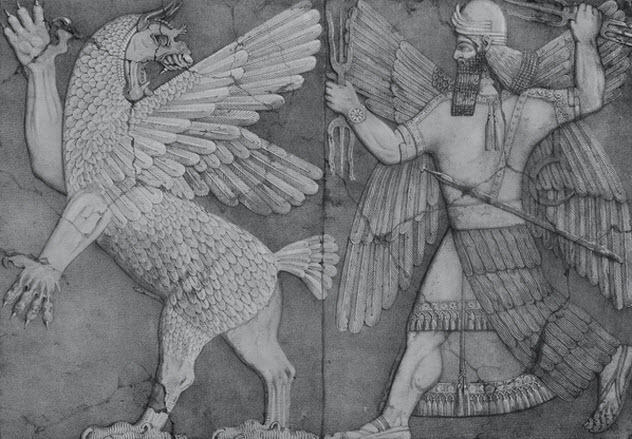
According to ancient Babylonian mythology, when you’re looking at the night sky, you’re actually looking at half of the corpse of the great dragon Tiamat.
The first divine beings in the world were Tiamat (the seas), Apsu (freshwater), and Mummu (the mist from both). Tiamat and Apsu eventually had equally divine children. But they were such demonic little monsters that it wasn’t long before Apsu suggested that they just kill all of the children.
Tiamat refused, so Apsu left to plan his murder spree alone. Before he could kill his children, one of them—Ea—struck first and killed Apsu. Ea built a palace on the remains of his father, hooked up with another goddess, and bore Marduk, the god of storms.
Understandably angry, Tiamat raised a vengeful army with the god Kingu at its head. They headed off to face Marduk, who took up arms with the condition that he rule the world when he won. With only Tiamat and Marduk left, Marduk used the wind to hold her mouth open as he shot an arrow down her throat, killing her.
There was even a location given for this great battle that ultimately gave birth to the world: the She-Goat Constellation. Tiamat became associated with the Corpse Constellation, which is appropriate.
Once Tiamat was dead, Marduk set about building the universe. Cutting the corpse of his grandmother in half, he used half to build the constellations of the night sky. He also left behind guards to ensure that her saltwater wouldn’t fall to the Earth, which was made up of the other half of her corpse.
6 Coma Berenices
Heavenly Hair
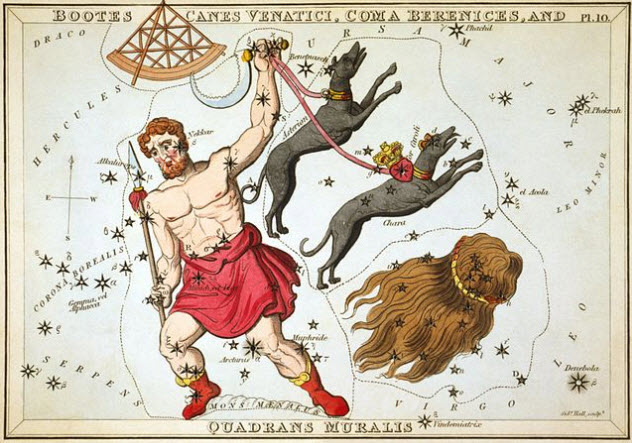
Although the stories that go along with the stars and constellations are generally the stuff of myths and legends, there is one exception: Coma Berenices.
This constellation is named for the wife of Ptolemy III, who sat at the head of Egypt around 250 BC. When Ptolemy headed off to war against Syria, his wife made a promise to the gods. If he returned safe and victorious, she would sacrifice her other most prized possession: her hair.
Cutting off her long hair, she placed it at the altar to Aphrodite at Zephyrium. The goddess apparently kept up her end of the bargain. Ptolemy III returned safe and victorious, but that wasn’t the end of the story.
Berenices’s hair was stolen from the temple. The king was understandably irate, but the situation was diffused by an unlikely person when the court astronomer stepped in.
Conon of Samos was able to convince Ptolemy III that Berenices’s hair hadn’t been stolen by a creepy, sweaty-palmed ruffian who was up to something disturbing. Instead, Conon told the king that it had been taken by Zeus.
The gods had been so honored by the queen’s sacrifice that they had put her hair among the stars as a faint galactic cluster that’s almost impossible to see on anything but the darkest of nights.
The story wasn’t attached to the constellation until centuries after it happened. The star cluster had been associated with Sampson’s hair and an ivy wreath before Tycho Brahe first cataloged it as Coma Berenices in 1602.
5 Draco And The Virgin
Revelations
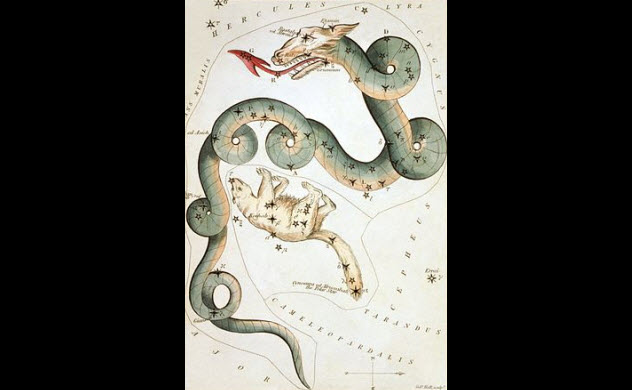
When 19th-century writer Elizabeth Cady Stanton looked at the role of women in the Bible, she began with Revelation 12:1. “Then I witnessed in Heaven an event of great significance. I saw a woman clothed with the Sun, with the Moon beneath her feet, and a crown of 12 stars on her head.”
The verse then told of a “great red dragon” that appeared as the woman gave birth to a boy. Although the woman was taken away to safety by God, the dragon pursued the child. Michael and the other angels faced off against the dragon. Michael won, casting the dragon—Satan—to Earth and out of the heavens.
The dragon was described as having seven heads and 10 horns. Draco, one of the largest constellations, stretches across seven signs of the zodiac. Originally elevated to a god in ancient Egypt, Draco gradually lost favor as the association with a serpent became one of evil.
Beside Draco was the constellation known as Cassiopeia, a lady with 12 stars (the signs of the zodiac) on her crown. The woman was also said to bear a “child,” a star that appeared in 945, 1264, and 1562, when it was recorded by Tycho Brahe.
For some, Draco is the embodiment of Satan. His presence in the night sky means that the Tribulation hasn’t occurred yet and that the battle between Michael and the angels of the Devil is still coming. According to that interpretation of the Bible, Satan will hand his authority over to the Antichrist when that happens.
4 Zu Bird
Pegasus And Taurus
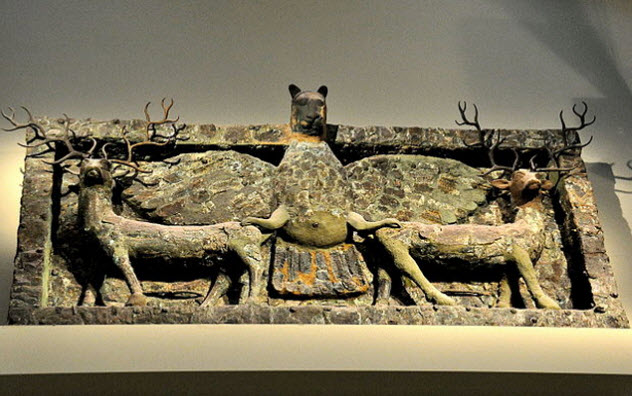
In ancient Sumeria, the constellations that we know as the winged horse and the bull were something different—a storm demon called Zu bird. Sadly, all we have of the legend is bits and pieces, but it’s terrifying nonetheless.
Zu bird was called a “worker of evil who raised the head of evil” and once tried to take the world from the other gods. Whoever held the Tablets of Destiny ruled the world, and Zu bird stole them in a story whose roots date back to around 2300 BC.
Enlil was the rightful owner of the tablets. Zu knew that if he took the tablets—along with Enlil’s crown and robes—he could raise himself to the top of the pantheon. So Zu watched and waited. When he saw his chance, he stole the tablets while Enlil was in the bathroom, doing his morning duties.
Anu, the god of the heavens, called on the others for a champion to confront the monstrous bird and take back the right to rule. Everyone declined. Although we’ve lost the part that tells us exactly what happened next, we’re fairly certain that the gods teamed up to take down this monstrous, evil threat. Presumably, they placed him in the night sky as a punishment or warning.
It’s still unclear who or what the Zu bird is because he’s never mentioned as one of the pantheon of Sumerian gods. The name pops up a couple of times in other texts, describing him as a divine bird of prey or storm bird that is compared to one king’s warriors.
Some scholars suggest that Zu bird isn’t really a bird in the traditional sense. As he is associated with the underworld, it’s possible that he was imagined as a dusty sort of spirit of the dead. These spirits were often said to float on the wings of birds.
When one king journeyed to the underworld, he described a creature there as having the head, hands, and feet of Zu. This suggested that there was nothing quite like Zu bird.
One scholar pieced together some clues to paint a terrifying picture of the storm demon. He was a four-winged devil with a head that was half human and half dog. He also had the hands of some kind of animal, the talons of an eagle for feet, and the tail of a scorpion.
3 Virgo, Bootes, And Canicula
Suicide, Murder, And A Faithful Dog
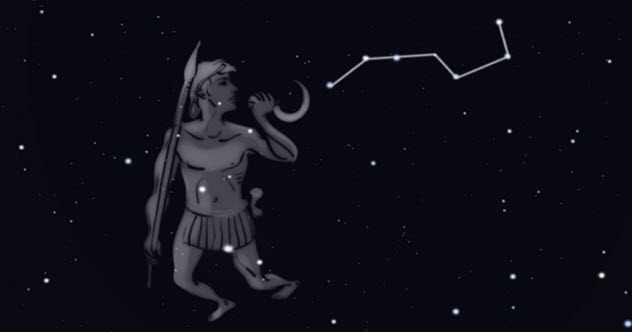
A single Greek legend tells the story of the constellations Virgo, Bootes, and Canicula. Although there are a couple of versions, they all relate the tragic tale of one family.
The basic story started with Dionysus heading into the mortal world to share the gift of wine. He selected a man named Ikarios (Icarius) to receive his secrets of planting and harvesting grapes and then converting them into wine.
Ikarios had a thriving vineyard when a goat broke in and began eating the vines. Outraged, Ikarios killed the goat and made a sack from his skin. Then he and his friends danced around it. From then on, Ikarios was called Bootes.
Once Bootes had made his wine, he shared it with his neighbors. Not knowing how to handle their alcohol, they drank themselves into a stupor.
Upon waking with pounding hangovers, they were convinced that Bootes had poisoned them to steal their land and graze his sheep in their territory. So the shepherds killed him. Depending on the story, they either threw his body down a well or buried him in his fields.
Meanwhile, his daughter, Erigone, started to worry when her father didn’t return home. She knew something was terribly wrong when Ikarios’s dog, Maera, showed up howling and whining.
The dog led her to her father’s body, where she was overcome with grief and loneliness. Erigone hanged herself rather than face the world without her father. As retribution for the wrongs done against them, all three were installed in a place among the stars.
2 Po I-k’ao And Ta Chi
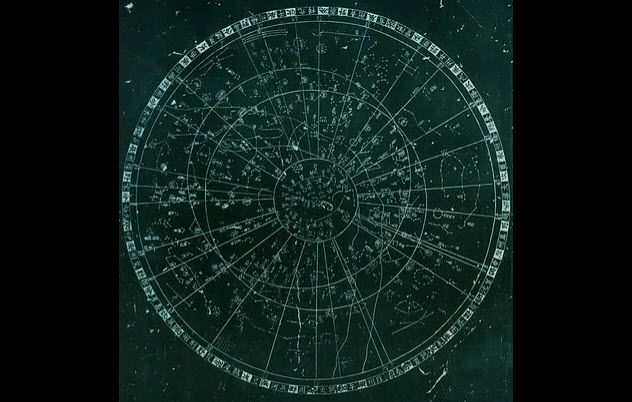
Ancient China recognized 28 constellations in the night sky. They were divided into five areas based on a central space and the cardinal directions. The sky was quite literally a reflection of what was happening on the land. Much like the terrestrial world, the sky was sometimes a battlefield.
The 28 constellations were named for great warriors who had distinguished themselves in battle. Furthermore, they were associated with things like animals, days, and stories.
The northern constellation of Tzu-Wei was associated with the story of Po I-k’ao, the eldest son of Wen Wang. Wen Wang was taken prisoner by a cruel dictator named Chou. It was left to Po to do everything that he could to free his father.
First, Po tried appealing to Chou’s good side by sending him 10 beautiful concubines, seven majestic chariots, a white-faced monkey, and a magic carpet that would instantly clear the head of the person who sat on it.
At the same time, Po became the target of the affections of Ta Chi, one of Chou’s concubines. After Po rebuffed her advances, she set about engineering his downfall by telling slanderous tales about him.
Eventually, she accused him—and his monkey—of conspiring against the king when the monkey committed the unforgivable sin of stealing a handful of her candies.
Po talked his way out of that one, and the episode ended with the death of the monkey. But he didn’t leave well enough alone and told the king about the true nature of the lying, deceitful woman. Unfortunately for Po, Ta Chi was the king’s favorite. When she insulted Po, he was overcome with rage and made the mistake of striking her.
Po was sentenced to be crucified. As he died, pieces of his flesh were removed, cooked, and served to his captive father. If Wen Wang refused the “hospitality” of his host, he could be executed on the grounds of showing contempt for the king.
The prisoner, knowing that the dishes were made from his son, ate them and avoided his own execution. Po was canonized and elevated to a place among the stars.
1 Delphinus The Dolphin
Dionysus And The Pirates
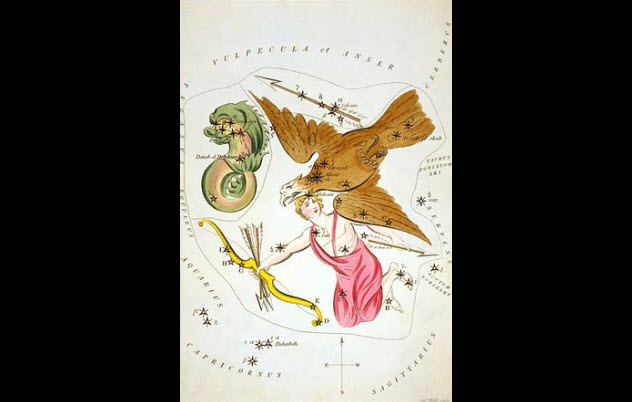
Delphinus the Dolphin is one of the smallest constellations. Even though it’s faint, the close grouping of its stars makes this constellation easy to discern in the night sky. But it’s not always characterized as a dolphin. Although we don’t know why, some texts call the pattern “Job’s coffin.”
The story of how a dolphin got into the night sky starts in ancient Greece with Dionysus. Presenting himself to mortals as a beautiful young man at the start of a voyage, he was picked up by a group of Tyrrhenian pirates.
The pirates decided to sell their captive for a profit. But when they tied him up, the ropes fell away. The helmsman recognized Dionysus as a divine being and tried to stop the rest of the pirates. But no one would listen to him. The pirates hoisted the sails and became determined to get what they could out of the god.
A rain of wine began to fall, and vines started to grow across the ship and up the masts. The vines blossomed and bore fruit. Even though the pirates were finally having second thoughts about what they were doing, it was too late.
Dionysus turned into a lion, summoned a bear to his side, and charged all the pirates except the helmsman. When the pirates jumped ship, they were turned into dolphins. Dionysus put the image of the dolphin in the night sky as a reminder.
There are a couple of different versions that describe how Dionysus drove the pirates mad. In some, the air is filled with music and they’re forced to dance until they hurl themselves overboard.
In others, Dionysus summons ghostly lions, panthers, and other big cats to clear the decks while the men slowly watch their hands turn to flippers, their spines curve, and their feet fuse.








